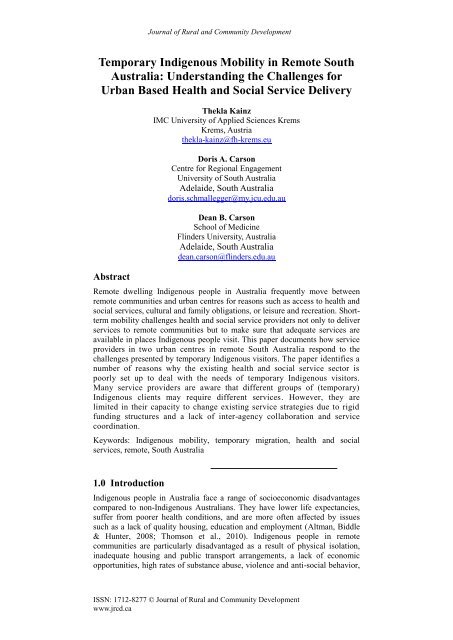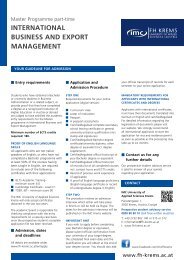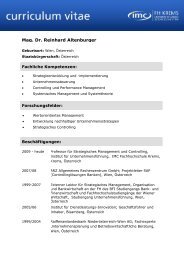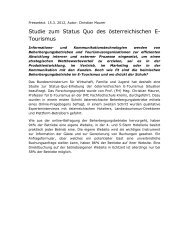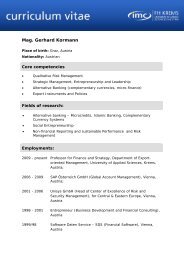Temporary Indigenous Mobility in Remote South Australia ...
Temporary Indigenous Mobility in Remote South Australia ...
Temporary Indigenous Mobility in Remote South Australia ...
Create successful ePaper yourself
Turn your PDF publications into a flip-book with our unique Google optimized e-Paper software.
Journal of Rural and Community Development<br />
<strong>Temporary</strong> <strong>Indigenous</strong> <strong>Mobility</strong> <strong>in</strong> <strong>Remote</strong> <strong>South</strong><br />
<strong>Australia</strong>: Understand<strong>in</strong>g the Challenges for<br />
Urban Based Health and Social Service Delivery<br />
Abstract<br />
Thekla Ka<strong>in</strong>z<br />
IMC University of Applied Sciences Krems<br />
Krems, Austria<br />
thekla-ka<strong>in</strong>z@fh-krems.eu<br />
Doris A. Carson<br />
Centre for Regional Engagement<br />
University of <strong>South</strong> <strong>Australia</strong><br />
Adelaide, <strong>South</strong> <strong>Australia</strong><br />
doris.schmallegger@my.jcu.edu.au<br />
Dean B. Carson<br />
School of Medic<strong>in</strong>e<br />
Fl<strong>in</strong>ders University, <strong>Australia</strong><br />
Adelaide, <strong>South</strong> <strong>Australia</strong><br />
dean.carson@fl<strong>in</strong>ders.edu.au<br />
<strong>Remote</strong> dwell<strong>in</strong>g <strong>Indigenous</strong> people <strong>in</strong> <strong>Australia</strong> frequently move between<br />
remote communities and urban centres for reasons such as access to health and<br />
social services, cultural and family obligations, or leisure and recreation. Shortterm<br />
mobility challenges health and social service providers not only to deliver<br />
services to remote communities but to make sure that adequate services are<br />
available <strong>in</strong> places <strong>Indigenous</strong> people visit. This paper documents how service<br />
providers <strong>in</strong> two urban centres <strong>in</strong> remote <strong>South</strong> <strong>Australia</strong> respond to the<br />
challenges presented by temporary <strong>Indigenous</strong> visitors. The paper identifies a<br />
number of reasons why the exist<strong>in</strong>g health and social service sector is<br />
poorly set up to deal with the needs of temporary <strong>Indigenous</strong> visitors.<br />
Many service providers are aware that different groups of (temporary)<br />
<strong>Indigenous</strong> clients may require different services. However, they are<br />
limited <strong>in</strong> their capacity to change exist<strong>in</strong>g service strategies due to rigid<br />
fund<strong>in</strong>g structures and a lack of <strong>in</strong>ter-agency collaboration and service<br />
coord<strong>in</strong>ation.<br />
Keywords: <strong>Indigenous</strong> mobility, temporary migration, health and social<br />
services, remote, <strong>South</strong> <strong>Australia</strong><br />
1.0 Introduction<br />
<strong>Indigenous</strong> people <strong>in</strong> <strong>Australia</strong> face a range of socioeconomic disadvantages<br />
compared to non-<strong>Indigenous</strong> <strong>Australia</strong>ns. They have lower life expectancies,<br />
suffer from poorer health conditions, and are more often affected by issues<br />
such as a lack of quality hous<strong>in</strong>g, education and employment (Altman, Biddle<br />
& Hunter, 2008; Thomson et al., 2010). <strong>Indigenous</strong> people <strong>in</strong> remote<br />
communities are particularly disadvantaged as a result of physical isolation,<br />
<strong>in</strong>adequate hous<strong>in</strong>g and public transport arrangements, a lack of economic<br />
opportunities, high rates of substance abuse, violence and anti-social behavior,<br />
ISSN: 1712-8277 © Journal of Rural and Community Development<br />
www.jrcd.ca
Ka<strong>in</strong>z, Carson, & Carson<br />
Journal of Rural and Community Development 7, 1 (2012) 16–36 17<br />
a lack of access to high-quality food, and a lack of accessible health and social<br />
services (Gruen, Weeramanthri, & Bailie, 2002; O’Dea, 2005; Vos et al.,<br />
2009).<br />
A number of government strategies, <strong>in</strong>clud<strong>in</strong>g the ‘Clos<strong>in</strong>g the Gap’ <strong>in</strong>itiative<br />
<strong>in</strong> 2008 or the Northern Territory Emergency Response <strong>in</strong> 2007, have recently<br />
been implemented that seek to improve the general health and liv<strong>in</strong>g conditions<br />
of <strong>Indigenous</strong> <strong>Australia</strong>ns (Bill<strong>in</strong>gs, 2010; Taylor & Carson, 2009). Health and<br />
social service agencies have <strong>in</strong>creas<strong>in</strong>gly started to address <strong>Indigenous</strong><br />
disadvantage <strong>in</strong> various fields such as: primary health care (<strong>in</strong>clud<strong>in</strong>g specific<br />
<strong>Indigenous</strong> health care programs), mental health, alcohol and drug<br />
management, domestic violence and sexual assault counsell<strong>in</strong>g, child,<br />
adolescent and family services, disability assistance, hous<strong>in</strong>g services and<br />
homelessness assistance, and welfare and employment services.<br />
Deliver<strong>in</strong>g such services to <strong>Indigenous</strong> people liv<strong>in</strong>g <strong>in</strong> remote communities,<br />
however, has rema<strong>in</strong>ed highly problematic, and there is ongo<strong>in</strong>g concern that<br />
health care and social support services are severely under-resourced <strong>in</strong> remote<br />
communities (Rob<strong>in</strong>son, d’Abbs, Bailie, & Togni, 2003; Smith & Elston,<br />
2007). For example, health cl<strong>in</strong>ics <strong>in</strong> remote and sparsely populated regions are<br />
very costly to ma<strong>in</strong>ta<strong>in</strong> and it is very difficult to recruit and reta<strong>in</strong> professional<br />
service staff (Auer & Carson, 2010). Similarly, outreach services from urban<br />
centres (where health specialists based <strong>in</strong> urban centres visit remote<br />
communities on a ‘fly-<strong>in</strong>/fly-out’ or ‘drive-<strong>in</strong>/drive-out’ basis) are very costly<br />
and are only available on certa<strong>in</strong> days of the week or month, leav<strong>in</strong>g gaps <strong>in</strong><br />
service provision <strong>in</strong> between visits (Guer<strong>in</strong> & Guer<strong>in</strong>, 2009). Moreover,<br />
outreach services beyond immediate primary health care, such as mental health<br />
programs and social services, are often just organised on an ad hoc basis and<br />
depend on time-limited project funds (Fuller et al., 2005; Gruen et al., 2002). A<br />
cont<strong>in</strong>uous supply of specialist health and social services <strong>in</strong> remote<br />
communities is therefore limited.<br />
Another major problem <strong>in</strong> address<strong>in</strong>g the health and social service needs of<br />
people from remote <strong>Indigenous</strong> communities is the high rate of temporary and<br />
seasonal <strong>Indigenous</strong> mobility. <strong>Remote</strong> dwell<strong>in</strong>g <strong>Indigenous</strong> people <strong>in</strong> <strong>Australia</strong><br />
have been described <strong>in</strong> the literature as highly mobile as they frequently move<br />
between remote communities and urban centres. These movements can be<br />
caused by a variety of motivational factors, <strong>in</strong>clud<strong>in</strong>g service related reasons<br />
(e.g. the need to access better health, education or employment services),<br />
leisure motivated reasons (e.g. visit<strong>in</strong>g family and friends, shopp<strong>in</strong>g, go<strong>in</strong>g to<br />
sport<strong>in</strong>g events, or visit<strong>in</strong>g enterta<strong>in</strong>ment facilities), cultural reasons (e.g.<br />
attend<strong>in</strong>g funerals), legal reasons (e.g. court appo<strong>in</strong>tments or short-term<br />
imprisonment), and safety related reasons (e.g. the need to escape violence and<br />
unpleasant liv<strong>in</strong>g conditions <strong>in</strong> remote home communities) (Carson &<br />
Rob<strong>in</strong>son, 2008; Long & Memmott, 2007; Prout & Yap, 2010). Short-term<br />
mobility can <strong>in</strong>clude planned and regular movements (e.g. people visit<strong>in</strong>g<br />
family members for Christmas each year, or people com<strong>in</strong>g <strong>in</strong>to town for<br />
shopp<strong>in</strong>g on payday), as well as unplanned and irregular movements (such as<br />
people com<strong>in</strong>g <strong>in</strong>to town for a funeral or to escape domestic violence <strong>in</strong> their<br />
home communities).<br />
Short-term mobility between remote communities and urban centres as a form<br />
of <strong>Indigenous</strong> ‘urban drift’ is not a recent phenomenon <strong>in</strong> <strong>Australia</strong> but has<br />
been observed for several decades (Carson & Taylor, 2009; Long et al., 2007).<br />
Yet such urban drift cont<strong>in</strong>ues to be portrayed <strong>in</strong> the literature and the public<br />
media as problematic for urban based service providers. Despite well-known<br />
periods of seasonal <strong>Indigenous</strong> mobility, service providers often struggle to
Ka<strong>in</strong>z, Carson, & Carson<br />
Journal of Rural and Community Development 7, 1 (2012) 16–36 18<br />
predict the extent and nature of temporary <strong>Indigenous</strong> <strong>in</strong>-migration and fail to<br />
respond to fluctuat<strong>in</strong>g service demands (Carson et al., 2009).<br />
This paper looks at the challenges for service provision <strong>in</strong> urban centres that<br />
remote dwell<strong>in</strong>g <strong>Indigenous</strong> people occasionally visit. The paper draws on results<br />
from case studies <strong>in</strong> two urban centres <strong>in</strong> remote <strong>South</strong> <strong>Australia</strong>. It exam<strong>in</strong>es how<br />
service providers <strong>in</strong> these towns attempt to deal with challenges associated with<br />
temporary <strong>Indigenous</strong> mobility. The paper identifies a range of systemic<br />
weaknesses <strong>in</strong> the current structure of the health and service sector <strong>in</strong> remote<br />
<strong>Australia</strong> which seem to prevent <strong>in</strong>dividual service providers from improv<strong>in</strong>g<br />
service delivery to temporary visitor populations. The <strong>in</strong>flexible nature of the<br />
service system—caused by rigid fund<strong>in</strong>g programmes and an overall policy<br />
approach that fails to recognise the apparent diversity of <strong>Indigenous</strong> service<br />
populations—appears to be one of the ma<strong>in</strong> reasons why service providers struggle<br />
to respond to the needs of temporary <strong>Indigenous</strong> visitors.<br />
1.1 <strong>Temporary</strong> <strong>Indigenous</strong> <strong>Mobility</strong> as a Challenge for Service<br />
Provision<br />
Service providers <strong>in</strong> urban centres commonly perceive high rates of temporary<br />
<strong>Indigenous</strong> mobility as a problem (Prout, 2008; Taylor, Johns, Williams, &<br />
Steenkamp, 2011). <strong>Temporary</strong> visitors from remote <strong>Indigenous</strong> communities<br />
tend to be seen as caus<strong>in</strong>g a range of social problems <strong>in</strong> the places they visit,<br />
<strong>in</strong>clud<strong>in</strong>g overcrowd<strong>in</strong>g <strong>in</strong> houses, temporary homelessness, illegal camp<strong>in</strong>g,<br />
anti-social behaviour, and <strong>in</strong>creased alcohol or drug abuse (Carson et al., 2009;<br />
Holmes & McRae-Williams, 2008). They are often seen as generat<strong>in</strong>g extra<br />
pressure for the local health and social service sector by divert<strong>in</strong>g resources<br />
away from local residents.<br />
One reason why service providers struggle to deal with temporary <strong>Indigenous</strong><br />
mobility is that mobility patterns are frequently perceived as be<strong>in</strong>g dom<strong>in</strong>ated<br />
by highly unplanned and unpredictable movements, thus mak<strong>in</strong>g it difficult to<br />
estimate and plan for fluctuat<strong>in</strong>g service demands. The size and composition of<br />
<strong>Indigenous</strong> visitor populations, the frequency of movements, as well as lengths<br />
of stay are not adequately captured by standard data sets such as the <strong>Australia</strong>n<br />
population census (Prout, 2009; Taylor, 1998). As a result, service providers <strong>in</strong><br />
urban centres tend to be ill-prepared to respond to the needs of an unknown<br />
service population that may be considerably larger <strong>in</strong> certa<strong>in</strong> places and at<br />
certa<strong>in</strong> times of the year than the usual resident population (Taylor, 1998;<br />
Warchivker, Tjapangati & Wakerman, 2000).<br />
Service providers <strong>in</strong> urban centres appear to be well aware of regular seasonal<br />
peaks <strong>in</strong> remote-to-urban <strong>Indigenous</strong> migration. For example, known periods of<br />
high mobility <strong>in</strong>clude the time around Christmas and Easter, regional sport<strong>in</strong>g<br />
carnivals, traditional periods of ceremonial activities, and seasonal climatic events<br />
such as the ‘wet season’ <strong>in</strong> the tropical north (from December to March) or the<br />
summer season <strong>in</strong> Central and <strong>South</strong> <strong>Australia</strong> (Carson & Taylor, 2011; Long et<br />
al., 2007; Northern Territory Treasury, 2008; Prout et al., 2010).<br />
However, few service agencies seem to collect consistent <strong>in</strong>ternal data to<br />
measure service demand fluctuations caused by short-term <strong>Indigenous</strong> <strong>in</strong>migration.<br />
Research <strong>in</strong> the Northern Territory (Northern Territory Treasury,<br />
2008) has shown that exist<strong>in</strong>g agency data collections are largely <strong>in</strong>complete<br />
and rarely comparable either between agencies or over time. They do not seem<br />
to capture key <strong>in</strong>dicators of short-term <strong>Indigenous</strong> mobility well, such as the<br />
place of usual residence, reasons for travel, the size of the travel party, or<br />
<strong>in</strong>tended length of stay. As a result, there appears to be a general lack of
Ka<strong>in</strong>z, Carson, & Carson<br />
Journal of Rural and Community Development 7, 1 (2012) 16–36 19<br />
evidence to develop an <strong>in</strong>formed understand<strong>in</strong>g of how many people move<br />
from remote communities to urban centres, at what po<strong>in</strong>t <strong>in</strong> time, for how long,<br />
and for what purpose. For example, a recent study <strong>in</strong> Darw<strong>in</strong> found that visitor<br />
estimates from service providers varied considerably across the service sector,<br />
rang<strong>in</strong>g from a couple of hundred to a couple of thousand visitors for the same<br />
period of time (Carson et al., 2011).<br />
One particular problem for service provision is that the mobile lifestyle of<br />
remote dwell<strong>in</strong>g <strong>Indigenous</strong> people is sometimes <strong>in</strong>compatible with the<br />
<strong>in</strong>flexible and permanent nature of urban-based service facilities. Service<br />
providers <strong>in</strong> urban centres, particularly <strong>in</strong> the fields of health, education and<br />
hous<strong>in</strong>g, tend to cater primarily to permanent local service populations with<br />
s<strong>in</strong>gle-locale sedentary lifestyles and struggle to adequately respond to service<br />
needs of ‘transient’ visitor populations (Prout, 2008). Prout’s (2008) study <strong>in</strong><br />
Western <strong>Australia</strong> found that service providers considered the mobile lifestyle<br />
of <strong>Indigenous</strong> people as a major threat to cont<strong>in</strong>uity of care, as patients from<br />
remote communities unexpectedly disrupted treatment and decided to leave<br />
and move on. Short-term <strong>Indigenous</strong> mobility was seen as a problem <strong>in</strong> terms<br />
of post-care monitor<strong>in</strong>g because transient people were difficult to track down<br />
once they had left urban centres (Prout, 2008).<br />
Intercultural differences between people from remote <strong>Indigenous</strong> communities<br />
and people manag<strong>in</strong>g and work<strong>in</strong>g <strong>in</strong> the urban-based ma<strong>in</strong>stream service sector<br />
(dom<strong>in</strong>ated by non-<strong>Indigenous</strong> <strong>Australia</strong>ns) are an additional challenge that<br />
complicates efficient service provision for <strong>Indigenous</strong> short-term visitors (Gruen<br />
et al., 2002; Prior, 2009). People from remote communities tend to have limited<br />
English language skills and struggle to understand practices that are common <strong>in</strong><br />
the ma<strong>in</strong>stream health sector (Gruen et al., 2002). For example, they often do not<br />
understand the need to make (and keep) scheduled appo<strong>in</strong>tments <strong>in</strong> the<br />
ma<strong>in</strong>stream service sector (Prout, 2008), or they feel uncomfortable when they<br />
have to deal with non-<strong>Indigenous</strong> service staff (Maher, 1999). Provid<strong>in</strong>g<br />
culturally appropriate services for <strong>Indigenous</strong> clients has repeatedly been<br />
identified as a key priority <strong>in</strong> <strong>Indigenous</strong> health care, <strong>in</strong> particular when deal<strong>in</strong>g<br />
with <strong>Indigenous</strong> people from remote and isolated communities (Gruen et al.,<br />
2002; Hayman, White, & Spurl<strong>in</strong>g, 2009; Maher, 1999; McLennan &<br />
Khavarpour, 2004). Strategies that have repeatedly been advocated <strong>in</strong> the<br />
literature <strong>in</strong>clude the employment of <strong>Indigenous</strong> staff as health and social<br />
workers, the use of <strong>in</strong>terpreters, the provision of <strong>in</strong>formation <strong>in</strong> language, and<br />
regular cultural awareness tra<strong>in</strong><strong>in</strong>g for service staff (Gruen et al., 2002; Hayman<br />
et al., 2009; Watson, Obersteller, Rennie, & Whitbread, 2001).<br />
While it seems to be a common argument <strong>in</strong> the literature that temporary<br />
<strong>Indigenous</strong> mobility presents considerable challenges for urban-based service<br />
providers, few studies to date have looked at how service providers deal with<br />
the challenges caused by short-term <strong>Indigenous</strong> visitor populations. This paper<br />
documents how the health and social service sector <strong>in</strong> two regional service<br />
centres <strong>in</strong> remote <strong>South</strong> <strong>Australia</strong> attempts to manage the challenges of<br />
temporary <strong>Indigenous</strong> mobility for service delivery. Us<strong>in</strong>g qualitative <strong>in</strong>-depth<br />
<strong>in</strong>terviews with health and social service providers, the research sought to<br />
address the follow<strong>in</strong>g questions:<br />
1. What do service providers perceive to be the ma<strong>in</strong> challenges for efficient<br />
service delivery to temporary <strong>Indigenous</strong> visitors?<br />
2. What strategies have been employed by service providers to deal with<br />
these challenges?<br />
3. How do service providers evaluate the effectiveness of these strategies?
Ka<strong>in</strong>z, Carson, & Carson<br />
Journal of Rural and Community Development 7, 1 (2012) 16–36 20<br />
2.0 Methods<br />
The research was conducted <strong>in</strong> two regional centres of <strong>South</strong> <strong>Australia</strong>’s<br />
remote Far North and Eyre Pen<strong>in</strong>sula regions (see Figure 1). The Far North<br />
covers a vast area of almost 800,000 km² which accounts for around 80% of<br />
<strong>South</strong> <strong>Australia</strong>’s landmass (RDA Far North SA, 2011). It has a population of<br />
approximately 28,670 people, the majority of whom are concentrated <strong>in</strong> the<br />
ma<strong>in</strong> regional centres Port Augusta, Coober Pedy, and Roxby Downs. M<strong>in</strong><strong>in</strong>g,<br />
energy, tourism, pastoralism and defence are the major economic sectors <strong>in</strong> the<br />
Far North. The Eyre Pen<strong>in</strong>sula region <strong>in</strong>cludes the western areas of the state<br />
and extends from Whyalla to the Western <strong>Australia</strong>n border. This region<br />
covers about 230,000 km² and has a population of approximately 57,500<br />
people (RDA Whyalla and Eyre Pen<strong>in</strong>sula, 2011). The ma<strong>in</strong> regional centres<br />
<strong>in</strong>clude Whyalla, Port L<strong>in</strong>coln and Ceduna. The area relies primarily on m<strong>in</strong><strong>in</strong>g<br />
and m<strong>in</strong>eral process<strong>in</strong>g, agriculture, aquaculture, fish<strong>in</strong>g and tourism.<br />
Figure 1. Far North and Eyre Pen<strong>in</strong>sula regions <strong>in</strong> <strong>South</strong> <strong>Australia</strong> (created by<br />
authors).<br />
The Far North and Eyre Pen<strong>in</strong>sula have the highest proportion of <strong>Indigenous</strong><br />
people <strong>in</strong> the <strong>South</strong> <strong>Australia</strong>. Accord<strong>in</strong>g to the last <strong>Australia</strong>n census <strong>in</strong> 2006<br />
(<strong>Australia</strong>n Bureau of Statistics, 2007), about 9.4% of residents (or 7,900<br />
people) were <strong>Indigenous</strong> (17.7% <strong>in</strong> the Far North, 4.9% on Eyre Pen<strong>in</strong>sula),<br />
compared to only 1.7% for <strong>South</strong> <strong>Australia</strong> as a whole. About a third of<br />
<strong>Indigenous</strong> residents lives <strong>in</strong> remote and very remote desert communities<br />
located on traditional lands, <strong>in</strong>clud<strong>in</strong>g the Anangu Pitjantjatjara<br />
Yankunytjatjara Lands (APY Lands) <strong>in</strong> the Northwest of the state on the<br />
border to the Northern Territory, the Maral<strong>in</strong>ga Tjarutja Lands <strong>in</strong> the Midwest,<br />
and the Yalata Lands on the West Coast (see Figure 2). Accord<strong>in</strong>g to the 2006<br />
census data, the APY Lands are home to more than 2,000 <strong>Indigenous</strong> people,<br />
with the larger communities be<strong>in</strong>g Iwantja (population size 340), Pukatja<br />
(330), Amata (320), and Mimili (300). Other <strong>Indigenous</strong> communities <strong>in</strong> the<br />
area <strong>in</strong>clude Oak Valley (population size 105), Yalata (100), and Umoona near<br />
Coober Pedy (75). Due to high rates of <strong>Indigenous</strong> mobility, the number of
Ka<strong>in</strong>z, Carson, & Carson<br />
Journal of Rural and Community Development 7, 1 (2012) 16–36 21<br />
people resid<strong>in</strong>g <strong>in</strong> these remote <strong>Indigenous</strong> communities fluctuates<br />
considerably at certa<strong>in</strong> times of the year, as illustrated by the follow<strong>in</strong>g<br />
statement from the Oak Valley community websites.<br />
“The local population ranges from 80-100. At times dur<strong>in</strong>g special<br />
cultural activities the population has risen to 1,500 people, with<br />
visitors from neighbour<strong>in</strong>g communities.” (Maral<strong>in</strong>ga Tjarutja<br />
Adm<strong>in</strong>istration, 2007)<br />
Figure 2. Map of Aborig<strong>in</strong>al Lands and communities <strong>in</strong> remote <strong>South</strong> <strong>Australia</strong><br />
(Source: Unit<strong>in</strong>gCare Wesley Adelaide, 2009, used with permission).<br />
The research for this paper was based on <strong>in</strong>-depth <strong>in</strong>terviews with health and<br />
social service providers <strong>in</strong> two regional centres <strong>in</strong> October and November<br />
2010. The names of <strong>in</strong>dividual service providers and the two regional centres<br />
have been de-identified <strong>in</strong> this paper for reasons of confidentiality. They are<br />
referred to as Service Provider A/B/C and Regional Centre A/B. The two<br />
regional centres were chosen based on anecdotal evidence, such as media<br />
reports and statements from local service providers, suggest<strong>in</strong>g that these<br />
towns were the ma<strong>in</strong> service centres for remote dwell<strong>in</strong>g <strong>Indigenous</strong> people<br />
and therefore received high (albeit fluctuat<strong>in</strong>g) volumes of short-term<br />
<strong>Indigenous</strong> <strong>in</strong>-migrants. There is a relatively high concentration of service
Ka<strong>in</strong>z, Carson, & Carson<br />
Journal of Rural and Community Development 7, 1 (2012) 16–36 22<br />
providers <strong>in</strong> both regional centres. Available services <strong>in</strong>clude, for example,<br />
hospitals, <strong>Indigenous</strong> health care centres, mental health service agencies,<br />
governmental and non-governmental welfare agencies, hous<strong>in</strong>g and transitional<br />
accommodation services, employment services, alcohol and drug management<br />
services, family and child support services, and counsell<strong>in</strong>g services for<br />
domestic violence and sexual abuse.<br />
Interview participants were identified from local service directories and<br />
through recommendations from local government members and representatives<br />
of the local Regional Development <strong>Australia</strong> (RDA) boards. In total, 27 out of<br />
50 identified local service providers could be recruited for an <strong>in</strong>-depth<br />
<strong>in</strong>terview, result<strong>in</strong>g <strong>in</strong> a response rate of 54%. Interview participants <strong>in</strong>cluded<br />
managers and employees of service agencies operat<strong>in</strong>g <strong>in</strong> the follow<strong>in</strong>g fields:<br />
primary health care; <strong>Indigenous</strong> health; hous<strong>in</strong>g and accommodation; child,<br />
youth and family services; alcohol and drug management; domestic violence;<br />
disability assistance; and non-government charity organisations. Interview<br />
participants represented a broad range of service agencies and generally<br />
reflected the composition of the local service sector. Hence, the relatively low<br />
response rate did not appear to have caused significant bias to the composition<br />
of the sample or the content of the <strong>in</strong>terview data.<br />
Interviews were semi-structured and followed a broad <strong>in</strong>terview guidel<strong>in</strong>e that<br />
sought to obta<strong>in</strong> rich qualitative data. Interview participants were asked about their<br />
personal experiences <strong>in</strong> deal<strong>in</strong>g with <strong>Indigenous</strong> visitors from remote communities<br />
and how they evaluated their role <strong>in</strong> provid<strong>in</strong>g services to this particular group of<br />
temporary service population. More specifically, service providers were asked<br />
about the type of challenges they have encountered when deal<strong>in</strong>g with temporary<br />
<strong>Indigenous</strong> visitors, the type of strategies they have used to respond to such<br />
challenges, and how well these strategies appeared to be work<strong>in</strong>g. Interviews were<br />
audiotaped with the approval of participants and subsequently transcribed <strong>in</strong> the<br />
form of verbatim quotes and summary statements.<br />
Interview transcripts were then reviewed and analysed <strong>in</strong>dependently by two<br />
researchers, us<strong>in</strong>g qualitative content analysis. The first step of analysis was<br />
based on an ‘open cod<strong>in</strong>g’ approach (Hoepfl, 1997), which focused on<br />
identify<strong>in</strong>g the ma<strong>in</strong> themes and re-occurr<strong>in</strong>g patterns <strong>in</strong> the raw data. Start<strong>in</strong>g<br />
from the three research questions, <strong>in</strong>terview transcripts were analysed to<br />
identify participant responses that reflected 1) the perceived challenges of<br />
temporary <strong>Indigenous</strong> mobility for service providers, 2) the type of strategies<br />
that service providers have used to respond to challenges, and 3) how service<br />
providers evaluated the effectiveness of these strategies.<br />
When read<strong>in</strong>g through the transcripts, the researchers manually assigned<br />
descriptive codes to <strong>in</strong>dividual quotes and grouped them <strong>in</strong>to mean<strong>in</strong>gful<br />
conceptual categories. For example, as shown <strong>in</strong> Figure 3, codes identify<strong>in</strong>g<br />
the perceived challenges of temporary <strong>Indigenous</strong> mobility for service<br />
provision <strong>in</strong>cluded the high seasonality of movements, movements triggered by<br />
unforeseen events such as funerals, unpredictable family movements, and the<br />
prom<strong>in</strong>ence of non-health related movements. All these codes reflected<br />
concerns of service providers that short-term mobility would cause high levels<br />
of service demand at certa<strong>in</strong> times of the year which were difficult to predict<br />
and exceeded exist<strong>in</strong>g service capacity. These codes were consequently<br />
grouped <strong>in</strong>to one conceptual category labelled ‘unpredictable movements –<br />
demand exceed<strong>in</strong>g service capacity’.<br />
The list of codes and conceptual data categories was gradually modified and<br />
extended as the analysis process proceeded. Through cont<strong>in</strong>uous re-
Ka<strong>in</strong>z, Carson, & Carson<br />
Journal of Rural and Community Development 7, 1 (2012) 16–36 23<br />
exam<strong>in</strong>ation of codes and conceptual categories, the researchers sought to<br />
identify mean<strong>in</strong>gful l<strong>in</strong>ks and connections between <strong>in</strong>dividual data categories<br />
to build a more holistic understand<strong>in</strong>g of the <strong>in</strong>terview data. This process is<br />
also referred to as ‘axial cod<strong>in</strong>g’ (Hoepfl, 1997). For example, it was found<br />
that one commonly proposed strategy to control excessive short-term mobility<br />
was the improvement of outreach services (Figure 3, second column).<br />
However, the <strong>in</strong>frequent delivery of outreach services, limited fund<strong>in</strong>g for a<br />
broader range of services, and the lack of ability to address non-health related<br />
movements were identified as reasons why service providers thought that<br />
exist<strong>in</strong>g outreach services contributed little to control short-term mobility<br />
(Figure 3, third column).<br />
F<strong>in</strong>ally, all codes and categories, as well as the identified connections between<br />
them, were grouped accord<strong>in</strong>g to the three research questions and a cod<strong>in</strong>g tree<br />
(a graphical outl<strong>in</strong>e of the various data codes and their connections) was<br />
developed to illustrate how the f<strong>in</strong>d<strong>in</strong>gs answered the study’s research<br />
questions (Figure 3).<br />
3.0 F<strong>in</strong>d<strong>in</strong>gs<br />
3.1 Perceived Challenges for Service Provision<br />
The f<strong>in</strong>d<strong>in</strong>gs confirmed previous observations <strong>in</strong> the literature (notably Taylor et<br />
al., 2011; Prout, 2008) that temporary <strong>Indigenous</strong> mobility was largely perceived<br />
as a problem by service providers. Most <strong>in</strong>terview participants agreed that the<br />
frequency and unpredictability of movements between remote <strong>Indigenous</strong><br />
communities and regional service centres were major challenges for service<br />
providers. The high seasonality of movements, for example as large numbers of<br />
temporary visitors moved <strong>in</strong>to regional centres around Christmas and dur<strong>in</strong>g the<br />
hot summer months, was identified as one of the ma<strong>in</strong> issues. Most service<br />
providers agreed that regional centres are not equipped to provide sufficient<br />
accommodation and support services dur<strong>in</strong>g such peak seasons. As a result,<br />
visitors from remote communities often become temporarily homeless and sleep<br />
rough, or they cause overcrowd<strong>in</strong>g <strong>in</strong> the houses of friends and relatives.<br />
Interest<strong>in</strong>gly, few service providers seemed to collect client data to measure<br />
temporary <strong>Indigenous</strong> visitor patterns. Only seven out 27 <strong>in</strong>terview participants<br />
confirmed that their agencies did keep client records that could identify shortterm<br />
visitors and ‘transient’ clients as such. However, many of them<br />
acknowledged that they did not specifically analyse such data to identify<br />
temporary visitor trends. As a result, estimates of visitor volumes were usually<br />
based on personal impressions and anecdotal reports rather than sound visitor<br />
statistics. Only two service providers (who provided accommodation services<br />
for temporary visitors) could give confident estimates of monthly visitor<br />
volumes. Yet even these providers <strong>in</strong>dicated that they struggled to predict daily<br />
fluctuations of service demand.<br />
“No [we never know how many people will come the next day]. Over<br />
a week we can average 16, 17 people on a Wednesday, Thursday night,<br />
but on a Sunday we might have 35. So it's a big change <strong>in</strong> number<br />
(…). It’s a big job for our cook because she doesn't really know how<br />
many people would come.” (Service Provider A)
Ka<strong>in</strong>z, Carson, & Carson<br />
Journal of Rural and Community Development 7, 1 (2012) 16–33 24<br />
Figure 3. Data Cod<strong>in</strong>g Tree.
Ka<strong>in</strong>z, Carson, & Carson<br />
Journal of Rural and Community Development 7, 1 (2012) 16–36 25<br />
Service providers identified a range of additional scenarios where sudden<br />
<strong>in</strong>creases <strong>in</strong> temporary visitors led to unexpected peaks <strong>in</strong> service demands that<br />
exceeded service capacity. Unforeseen events, <strong>in</strong>clud<strong>in</strong>g funerals and other<br />
cultural obligations, were critical situations when large numbers of temporary<br />
visitors come to regional centres and cause shortages to available<br />
accommodation and services. In particular, the cultural obligation to support<br />
family members who have gone to hospital or prison was seen as a problem.<br />
Large family groups frequently follow their relatives <strong>in</strong>to town and wait until<br />
they are released from hospital or prison. Although service providers were well<br />
aware of such movement patterns there were no adequate strategies <strong>in</strong> place to<br />
measure, plan for and respond to service needs of those additional visitors who<br />
come to support family.<br />
“[I]f you are an old fella and you go down to hospital, they [family<br />
members] all go then down to [Regional Centre A]. And because there is<br />
no place to stay they camp <strong>in</strong> the bush camp, they camp everywhere. So<br />
hospitalisation – you take one person and put <strong>in</strong> a hospital and his or her<br />
family will come back to be with that person.” (Service Provider B)<br />
Another common scenario that service providers struggled to deal with was the<br />
prom<strong>in</strong>ence of non-health related visitors. Frequently, remote dwell<strong>in</strong>g<br />
<strong>Indigenous</strong> people visit one of the regional centres for holiday and leisure related<br />
purposes. They seek to escape the summer heat <strong>in</strong> the desert, want to spend some<br />
time near the ocean and the beach, want to visit family, want to do shopp<strong>in</strong>g, or<br />
want to engage <strong>in</strong> certa<strong>in</strong> leisure activities (<strong>in</strong>clud<strong>in</strong>g dr<strong>in</strong>k<strong>in</strong>g and gambl<strong>in</strong>g)<br />
that are not available <strong>in</strong> remote communities. A lack of affordable temporary<br />
accommodation options for these people, as well as a lack of public transport and<br />
<strong>in</strong>formation services, can then lead to numerous problems as visitors get stranded<br />
<strong>in</strong> town. They have nowhere to stay, no transport back home to their<br />
communities, no <strong>in</strong>formation on what to do when they become stuck <strong>in</strong> town,<br />
and eventually run out of money and become homeless. Quite often, more family<br />
members then follow to look for their stranded relatives, and they might<br />
themselves become stuck <strong>in</strong> town due to a lack of transport and support services.<br />
“And you would f<strong>in</strong>d too that (…) the men would come <strong>in</strong>to town<br />
dr<strong>in</strong>k<strong>in</strong>g and wouldn't come home for two weeks. So then the wife and the<br />
kids would come <strong>in</strong>to town look<strong>in</strong>g for them. But then they get <strong>in</strong>to town<br />
and then they get stranded, you know, with no lift back to the community.<br />
So then that becomes another hous<strong>in</strong>g issue.” (Service Provider C)<br />
Similar to Prout’s (2008) f<strong>in</strong>d<strong>in</strong>gs, service providers <strong>in</strong> the health sector were<br />
concerned that the transient nature of temporary <strong>Indigenous</strong> visitors presented<br />
substantial challenges for post-care monitor<strong>in</strong>g and follow-up treatment.<br />
Service providers often described visitors from remote communities as<br />
‘it<strong>in</strong>erants’ who are difficult to trace for follow-up checks, as many of them do<br />
not immediately go back home to their communities but make a detour to visit<br />
family <strong>in</strong> other places and communities. Some service providers were<br />
particularly concerned that these ‘it<strong>in</strong>erants’ would engage <strong>in</strong> activities such as<br />
dr<strong>in</strong>k<strong>in</strong>g or gambl<strong>in</strong>g and then forget to come back for their follow-up medical<br />
checks, or they forget to take their medication.
Ka<strong>in</strong>z, Carson, & Carson<br />
Journal of Rural and Community Development 7, 1 (2012) 16–36 26<br />
Another issue commonly associated with transience was the difficulty <strong>in</strong><br />
obta<strong>in</strong><strong>in</strong>g personal and medical records from clients who were temporary<br />
visitors. For example, service providers criticised that visitors often did not<br />
br<strong>in</strong>g their identification documents, Medicare (health <strong>in</strong>surance) or Centrel<strong>in</strong>k<br />
(welfare) details, bank key cards, and prescribed medication because they left<br />
their communities at short notice (e.g. for a funeral or because a family<br />
member was rushed off to hospital) and did not have time to prepare their<br />
documents. In those cases, service providers had to go through a lot of extra<br />
paperwork to chase down the required details for deliver<strong>in</strong>g services.<br />
Intercultural differences, <strong>in</strong>clud<strong>in</strong>g language barriers, the fear of hav<strong>in</strong>g to go to<br />
a ma<strong>in</strong>stream cl<strong>in</strong>ic and deal with ‘white’ service staff, and the perception that<br />
males should not be treated by females (or vice versa), were other challenges that<br />
service providers repeatedly encountered. Some <strong>in</strong>terview participants<br />
mentioned that hav<strong>in</strong>g to deal with different <strong>Indigenous</strong> family groups was<br />
sometimes problematic because of <strong>in</strong>ternal conflicts and rivalries between<br />
different families. Service providers had to make sure to keep clients from<br />
rivall<strong>in</strong>g families separate to avoid fights and violent behaviour. This was<br />
particularly difficult for temporary accommodation providers (such as hostels,<br />
emergency shelters, town camps, etc.) where encounters between different<br />
<strong>Indigenous</strong> groups were more difficult to avoid.<br />
Similar to Prout’s (2008) study, <strong>in</strong>terview participants described the<br />
<strong>in</strong>compatibility of temporary <strong>Indigenous</strong> lifestyles with the <strong>in</strong>flexible and<br />
stationary nature of the ma<strong>in</strong>stream service sector as a major challenge for<br />
service provision. In particular, a lack of understand<strong>in</strong>g among <strong>Indigenous</strong><br />
visitors about the structure and requirements with<strong>in</strong> the ma<strong>in</strong>stream service<br />
sector was repeatedly seen as a problem. For example, service providers<br />
struggled to communicate to <strong>Indigenous</strong> visitors the need to make<br />
appo<strong>in</strong>tments for medical services or that particular services were not available<br />
outside normal office hours.<br />
“There are a lot of good services available around [Regional Centre A].<br />
However, [the problem is] their chaotic lifestyle, liv<strong>in</strong>g from relative to<br />
relative. They might have an appo<strong>in</strong>tment today, but there might have<br />
been an explosion <strong>in</strong> the house last night of dr<strong>in</strong>k<strong>in</strong>g and stuff. They are<br />
not gonna keep that appo<strong>in</strong>tment today, but most of the ma<strong>in</strong>stream<br />
places have appo<strong>in</strong>tments. So that's where I don't th<strong>in</strong>k is a flexibility for<br />
these people. Like it happened last night, and at 3 o'clock this afternoon<br />
they th<strong>in</strong>k 'Oh, I need to go and get a health check, I can just go and see<br />
them.' Well, they can't. The appo<strong>in</strong>tment was at 10 o'clock this morn<strong>in</strong>g.<br />
We don't seem to be flexible enough to meet the lifestyle and the day-to-<br />
day liv<strong>in</strong>g that these people survive <strong>in</strong>.” (Service Provider D)<br />
Service providers described the health and social service system as highly<br />
complex with lots of different agencies provid<strong>in</strong>g a wide range of specialised<br />
services. Some <strong>in</strong>terview participants thought that the system was far too<br />
complex for <strong>Indigenous</strong> visitors to understand and navigate on their own. For<br />
example, many service agencies were limited <strong>in</strong> their capacity to respond to<br />
holistic <strong>Indigenous</strong> service needs because they were only funded to provide<br />
specific services (e.g. accommodation only, drug and alcohol services only, or
Ka<strong>in</strong>z, Carson, & Carson<br />
Journal of Rural and Community Development 7, 1 (2012) 16–36 27<br />
mental health services only). Hence, if their clients needed additional services<br />
they had to refer them on to other agencies—sometimes with the result that<br />
<strong>Indigenous</strong> visitors not used to the system became disoriented and lost <strong>in</strong> larger<br />
urban centres. A lack of experience <strong>in</strong> navigat<strong>in</strong>g their own way around urban<br />
centres, paired with language barriers and a severe gap <strong>in</strong> <strong>in</strong>formation and<br />
support services (for example, <strong>in</strong>terpreters or social workers) was one of the<br />
ma<strong>in</strong> reasons why <strong>Indigenous</strong> visitors often became lost and ultimately ended up<br />
be<strong>in</strong>g homeless.<br />
“Many of the people who come down tend to have complex needs and,<br />
you know, without either <strong>in</strong>formation ahead of time before they come, or<br />
<strong>in</strong>formation on arrival and support to be able to navigate the range of<br />
systems and services that are here <strong>in</strong> an urban or regional centre, people<br />
can become vulnerable really quickly. (…) It could be simple th<strong>in</strong>gs like<br />
'You catch the bus to the hospital on that side of the road not this side of<br />
the road.' Unless that’s expla<strong>in</strong>ed to people… And there's also issues with<br />
language, you know, English be<strong>in</strong>g a second or third language. So even<br />
access to <strong>in</strong>terpreters—how do people access <strong>in</strong>terpreters down here? That<br />
sort of stuff, or support to fill out a form.” (Service Provider E)<br />
3.2 Strategies to Manage Challenges and Factors Limit<strong>in</strong>g Their<br />
Effectiveness<br />
Service providers were asked how they were try<strong>in</strong>g to deal with the challenges<br />
aris<strong>in</strong>g from temporary <strong>Indigenous</strong> mobility and how they evaluated the<br />
effectiveness of these strategies. Interview participants listed a range of<br />
strategies that were used to deal with temporary <strong>Indigenous</strong> visitors but also<br />
identified several reasons why they thought that these strategies were not<br />
work<strong>in</strong>g as well as they should.<br />
Some <strong>in</strong>terview participants thought that an <strong>in</strong>crease <strong>in</strong> outreach services <strong>in</strong> the<br />
health care sector was one of the most important strategies to reduce the<br />
number of temporary visitors seek<strong>in</strong>g medical treatment <strong>in</strong> regional centres.<br />
However, they admitted that current models of outreach services were largely<br />
<strong>in</strong>effective because of the <strong>in</strong>frequent delivery of service (service visits to<br />
communities are limited to a couple of times per month), a lack of qualified<br />
staff, and a lack of sufficient fund<strong>in</strong>g to extend outreach services beyond basic<br />
primary health care.<br />
“[Service provider F] gets money to look after people here <strong>in</strong><br />
[Regional Centre A]. But there needs to be extra money because what<br />
doesn’t happen but should happen—there should be outreach services.<br />
(…) There should be dedicated health workers that go out to people’s<br />
homes. (…) Not much service is given, believe me, we can vouch for<br />
this. They might go up to those areas once a month, they might go up<br />
once every three months, and there is no conversation <strong>in</strong> between. A<br />
lot of it is because of fund<strong>in</strong>g.” (Service Provider G)
Ka<strong>in</strong>z, Carson, & Carson<br />
Journal of Rural and Community Development 7, 1 (2012) 16–36 28<br />
In addition, some participants criticised that outreach services would only meet<br />
the needs of a very small proportion of temporary visitors—those who need<br />
medical services but do not want to leave their communities. Accord<strong>in</strong>g to one<br />
participant, a major flaw <strong>in</strong> the design of outreach services is the general<br />
assumption that the delivery of better health services to remote communities<br />
would automatically stop people’s desire to leave their home communities and<br />
visit regional centres. This approach does not take <strong>in</strong>to account that leisure,<br />
family and culture related reasons are often the ma<strong>in</strong> drivers of <strong>Indigenous</strong><br />
mobility decisions (Carson et al., 2008; Long et al., 2007; Prout et al., 2010),<br />
and that an <strong>in</strong>crease <strong>in</strong> outreach services is unlikely to affect mobility patterns<br />
of non-health related temporary migrants.<br />
Although service providers were aware of the diversity of travel motivations, it<br />
seemed that many of them failed to recognise that people with different travel<br />
motivations are likely to have different service needs. For example, several<br />
<strong>in</strong>terview participants admitted that the service sector was not set up well to<br />
deal with the large proportion of temporary <strong>Indigenous</strong> ‘leisure visitors’ <strong>in</strong><br />
regional centres. They argued that, while the <strong>in</strong>flux of large numbers of leisure<br />
visitors was a long stand<strong>in</strong>g issue, there were still not enough support services<br />
such as accommodation, transport and <strong>in</strong>formation services <strong>in</strong> place to respond<br />
to the needs of these visitors. However, fund<strong>in</strong>g limitations and an overspecialisation<br />
<strong>in</strong> the service sector (i.e. agencies can only provide the service<br />
they are specifically funded for) meant that most service agencies simply did<br />
not feel responsible for this target group.<br />
It was also argued that the few available service providers that cater<br />
specifically to temporary <strong>Indigenous</strong> visitors (such as hostels and transitional<br />
accommodation centres) clearly did not meet the needs of <strong>Indigenous</strong> leisure<br />
visitors. <strong>Temporary</strong> accommodation facilities tend to have numerous<br />
restrictions, for example on length of stay, group size, mixed dormitories,<br />
curfews, and alcohol consumption. <strong>Temporary</strong> leisure visitors often want to<br />
avoid such restrictions and rather camp <strong>in</strong> public places <strong>in</strong>stead. Participants <strong>in</strong><br />
both regional centres criticised that there were almost no services <strong>in</strong> place to<br />
look after <strong>Indigenous</strong> leisure visitors who preferred ‘sleep<strong>in</strong>g rough’ to stay<strong>in</strong>g<br />
<strong>in</strong> one of the <strong>Indigenous</strong> town camps.<br />
“But [the public campsite] is an area where people go because they can’t<br />
dr<strong>in</strong>k <strong>in</strong> the Town Camp and they can’t dr<strong>in</strong>k <strong>in</strong> the community itself.<br />
The community is a dry area so they go to [the public campsite] to party,<br />
to dr<strong>in</strong>k, and they tend to camp at night and come back to town <strong>in</strong> the<br />
morn<strong>in</strong>gs. (…) But they [local council] are reluctant to put any services<br />
out there or any <strong>in</strong>frastructure. They are reluctant to put toilets, water<br />
supply, permanent services out there because the view is that it will<br />
encourage more people to camp there.” (Service Provider H)<br />
The most common management strategies identified by <strong>in</strong>terview participants<br />
were aimed at provid<strong>in</strong>g services <strong>in</strong> a culturally appropriate way to overcome<br />
issues of <strong>in</strong>tercultural differences. These strategies were consistent with many of<br />
the strategies that have previously been advocated <strong>in</strong> the literature (Gruen et al.,<br />
2002; Hayman et al., 2009; McLennan et al., 2004; Watson et al., 2001). They<br />
<strong>in</strong>cluded the employment of <strong>Indigenous</strong> health and social workers who were<br />
familiar with <strong>Indigenous</strong> cultural backgrounds; the design of <strong>in</strong>formation<br />
material (e.g. brochures and videos) <strong>in</strong> <strong>Indigenous</strong> languages; the use of
Ka<strong>in</strong>z, Carson, & Carson<br />
Journal of Rural and Community Development 7, 1 (2012) 16–36 29<br />
language <strong>in</strong>terpreters; the <strong>in</strong>tegration of traditional <strong>Indigenous</strong> healers<br />
(Ngangkari) <strong>in</strong> ma<strong>in</strong>stream services; the provision of same-sex service staff for<br />
<strong>Indigenous</strong> clients; and the requirement for non-<strong>Indigenous</strong> staff to regularly<br />
participate <strong>in</strong> some form of cultural awareness tra<strong>in</strong><strong>in</strong>g.<br />
Despite the long list of culturally appropriate services, it appeared that many<br />
service providers applied the same strategies to all of their <strong>Indigenous</strong> clients<br />
and did not differentiate between service needs of temporary visitors and<br />
permanent residents. In particular, service agencies <strong>in</strong> the ma<strong>in</strong>stream health<br />
sector (e.g. hospitals) were not set up to respond to more complex service<br />
needs of temporary visitors. Accord<strong>in</strong>g to one participant, ma<strong>in</strong>stream health<br />
providers tend to focus on deliver<strong>in</strong>g specific health services only. There is<br />
limited recognition of the need to check whether temporary clients (and their<br />
families who usually follow them) have adequate access to accommodation,<br />
transport, <strong>in</strong>formation, counsell<strong>in</strong>g and family support while they are <strong>in</strong> town.<br />
Several service providers acknowledged that this apparent lack of attention to<br />
temporary visitor needs existed simply because ‘transient’ <strong>Indigenous</strong> people<br />
were not seen as a service priority compared to the larger permanent resident<br />
population. They were seen as only ‘pass<strong>in</strong>g through’ and were then expected<br />
to become someone else’s problem.<br />
“The other th<strong>in</strong>g that we f<strong>in</strong>d as well is that people aren't connected to<br />
services when they come here, they are treated as transient. So for<br />
example, a child may enrol at school or a young adult may go <strong>in</strong>to<br />
[welfare agency] and be a job seeker. But how they are treated by those<br />
services is 'Oh they are only transient, just give them their welfare'. (…)<br />
Or education. They might get enrolled at school but then, if they don't<br />
show up for a week, people just k<strong>in</strong>d of go 'Oh they must have gone<br />
back'. And nobody does the follow-up to ensure where they are. And it<br />
could be that the family is under enormous stress. It could be about<br />
homelessness that these young people may not be attend<strong>in</strong>g school or<br />
whatever. We should not make the assumptions that they’ve just gone<br />
back, which is what we do. We treat them like they are transient, treat<br />
them like they are just pass<strong>in</strong>g through.” (Service Provider I)<br />
Many service providers argued that the service sector needed to differentiate<br />
more systematically between different types of <strong>Indigenous</strong> clients. A common<br />
argument was that service providers would have to apply better ‘case<br />
management’ approaches that would allow them to respond to complex<br />
<strong>Indigenous</strong> service needs on a case by case basis and provide better targeted<br />
health and support services, as well as post-care monitor<strong>in</strong>g. Some agencies have<br />
started to employ specific <strong>Indigenous</strong> service coord<strong>in</strong>ators (such as Aborig<strong>in</strong>al<br />
liaison officers or Aborig<strong>in</strong>al patient pathway officers) to coord<strong>in</strong>ate different<br />
services and make sure that <strong>Indigenous</strong> clients get all the services they need<br />
dur<strong>in</strong>g their stay. Aga<strong>in</strong>, however, these support services were only targeted<br />
towards visitors who came specifically to access health services. They were not<br />
designed to help visitors com<strong>in</strong>g for non-health related purposes.<br />
Some participants acknowledged that, while <strong>in</strong>dividual case management and a<br />
bigger picture approach to <strong>Indigenous</strong> service needs were critical, attempts to
Ka<strong>in</strong>z, Carson, & Carson<br />
Journal of Rural and Community Development 7, 1 (2012) 16–36 30<br />
apply such case management approaches were often stalled by a somewhat<br />
embedded lack of collaboration between <strong>in</strong>dividual agencies. Due to rigid<br />
government fund<strong>in</strong>g models and the temporary nature of many fund<strong>in</strong>g<br />
programmes, service providers essentially saw themselves as compet<strong>in</strong>g for<br />
clients to cont<strong>in</strong>ue to receive government fund<strong>in</strong>g. One service provider, for<br />
example, mentioned that one of the major concerns for his agency was to<br />
ma<strong>in</strong>ta<strong>in</strong> government fund<strong>in</strong>g and keep their staff employed. Service agencies<br />
constantly have to conv<strong>in</strong>ce fund<strong>in</strong>g agencies (<strong>in</strong> fund<strong>in</strong>g applications and<br />
performance reviews) that they have a large enough client base that warrants<br />
ongo<strong>in</strong>g government support. As a result, many service agencies seek to cater<br />
to the largest possible target group (usually the permanent resident population).<br />
This ultimately causes services to become very similar to each other, <strong>in</strong>creases<br />
competition and limits <strong>in</strong>ter-agency collaboration.<br />
“I don't th<strong>in</strong>k that services work together enough, you know like<br />
communicate between each other enough. There’s a lot of services that<br />
do the same th<strong>in</strong>g, so there is sometimes a lot of protection about<br />
clients and services and th<strong>in</strong>gs like that.” (Service Provider J)<br />
The rigid fund<strong>in</strong>g structure was also one of the ma<strong>in</strong> reasons why most service<br />
providers cannot afford design<strong>in</strong>g more differentiated services that meet the<br />
needs of various temporary <strong>Indigenous</strong> visitor groups. Hav<strong>in</strong>g to service the<br />
largest possible group of clients means that there is limited room for service<br />
agencies to develop differentiated strategies for ‘niche markets’, even if they<br />
know these niche markets exist. A few service providers openly admitted that<br />
they did not have the resources and capacities to provide specific services to<br />
temporary visitors as they had to focus their attention on the permanent<br />
resident population.<br />
“We have people com<strong>in</strong>g here look<strong>in</strong>g for assistance to get from A to<br />
B, and usually we refer them to [Service provider K]. (…) We just<br />
refer them on to the agencies, who we th<strong>in</strong>k can give them immediate<br />
help. We don't run a specific service to assist transient people get from<br />
A to B. It's more programs <strong>in</strong> [Regional Centre B] for the <strong>Indigenous</strong><br />
people <strong>in</strong> [Regional Centre B].” (Service Provider L)<br />
As illustrated <strong>in</strong> the previous quote, attempts to improve collaboration and<br />
coord<strong>in</strong>ation between service agencies were essentially limited to referr<strong>in</strong>g<br />
clients on to other agencies if they could not provide the required services<br />
themselves. There appeared to be limited <strong>in</strong>ter-agency collaboration <strong>in</strong> terms of<br />
exchang<strong>in</strong>g <strong>in</strong>formation and data to improve the actual process of plann<strong>in</strong>g and<br />
design<strong>in</strong>g services. Aga<strong>in</strong>, some service providers blamed fund<strong>in</strong>g constra<strong>in</strong>ts<br />
for the lack of shar<strong>in</strong>g <strong>in</strong>formation resources. They also mentioned that<br />
different fund<strong>in</strong>g agencies used different data systems and did not allow the<br />
exchange of <strong>in</strong>formation due to issues of confidentiality and client protection.<br />
The lack of collaboration and <strong>in</strong>formation exchange was particularly<br />
problematic <strong>in</strong> cross-border cases where clients from the remote APY Lands<br />
obta<strong>in</strong>ed services from agencies <strong>in</strong> both <strong>South</strong> <strong>Australia</strong> and the Northern<br />
Territory. Different fund<strong>in</strong>g structures and fund<strong>in</strong>g responsibilities <strong>in</strong> both<br />
jurisdictions made it almost impossible to set up a more systematic exchange<br />
of client <strong>in</strong>formation across the border.
Ka<strong>in</strong>z, Carson, & Carson<br />
Journal of Rural and Community Development 7, 1 (2012) 16–36 31<br />
“Like [service provider M], their ma<strong>in</strong> office is based <strong>in</strong> Alice Spr<strong>in</strong>gs.<br />
They’ve got a whole database which is all connected but the hospital<br />
here can’t get <strong>in</strong>to that because they are not our clients. So they are<br />
different health cl<strong>in</strong>ics, (…) they’ve got lots of health cl<strong>in</strong>ics around<br />
the APY-Lands, so they are all connected but when those APY-Lands<br />
people come here, we can’t connect <strong>in</strong>. We can r<strong>in</strong>g and ask questions<br />
but we can’t connect <strong>in</strong>.” (Service Provider N)<br />
4.0 Conclusion<br />
This research sought to get an <strong>in</strong>-depth perspective from urban-based health<br />
and social service providers on how they attempt to deal with temporary<br />
<strong>Indigenous</strong> mobility and the challenges it presents for service provision.<br />
Service providers <strong>in</strong> two regional centres of <strong>South</strong> <strong>Australia</strong> were <strong>in</strong>terviewed<br />
to identify 1) what the ma<strong>in</strong> challenges are for efficient service delivery to<br />
temporary <strong>Indigenous</strong> visitors; 2) what strategies they have used to manage<br />
these challenges; and 3) how well they thought these strategies were work<strong>in</strong>g.<br />
The study has found that temporary <strong>Indigenous</strong> mobility presents a range of<br />
challenges for service providers, <strong>in</strong>clud<strong>in</strong>g: 1) the difficulty to measure and<br />
forecast short-term mobility and plan for fluctuat<strong>in</strong>g demands, 2) issues for<br />
follow-up treatment and post-care monitor<strong>in</strong>g, 3) <strong>in</strong>tercultural differences, 4)<br />
the <strong>in</strong>compatibility of <strong>Indigenous</strong> mobile lifestyles with the highly <strong>in</strong>flexible<br />
and stationary service system, 5) and a lack of specific support services for<br />
temporary visitors (<strong>in</strong>clud<strong>in</strong>g transport and <strong>in</strong>formation). These f<strong>in</strong>d<strong>in</strong>gs are<br />
not necessarily new and confirm previous observations <strong>in</strong> the literature that<br />
temporary <strong>Indigenous</strong> mobility is commonly regarded as problematic for<br />
service providers <strong>in</strong> urban centres (Carson et al., 2009; Holmes et al., 2008;<br />
Prout, 2008; Taylor et al., 2011).<br />
The study has shown that service providers <strong>in</strong> the two case study locations<br />
have started to implement a range of management strategies to deal with these<br />
challenges, <strong>in</strong>clud<strong>in</strong>g improved outreach services (seek<strong>in</strong>g to reduce temporary<br />
migration), culturally appropriate service design, case management approaches<br />
and specific <strong>Indigenous</strong> service coord<strong>in</strong>ator positions and service delivery<br />
programmes. Aga<strong>in</strong>, these f<strong>in</strong>d<strong>in</strong>gs are not surpris<strong>in</strong>g given that similar<br />
solutions have repeatedly been discussed <strong>in</strong> the literature (see, for example,<br />
Fuller et al., 2005; Gruen et al., 2002; Hayman et al., 2009; Maher, 1999;<br />
McLennan et al., 2004; Watson et al., 2001;).<br />
What this research has contributed, however, is an additional perspective on<br />
how service providers evaluate the effectiveness of exist<strong>in</strong>g strategies. Service<br />
providers have identified a range of issues that cont<strong>in</strong>ue to place constra<strong>in</strong>ts on<br />
the implementation of successful management strategies and perpetuate gaps <strong>in</strong><br />
the range and quality of services for temporary <strong>Indigenous</strong> visitors.<br />
Rigid and <strong>in</strong>flexible government fund<strong>in</strong>g models were described as one of the<br />
ma<strong>in</strong> reasons for the lack of appropriate services for temporary <strong>Indigenous</strong><br />
visitors. Fund<strong>in</strong>g constra<strong>in</strong>ts were responsible for the extensive fragmentation<br />
and over-specialisation of services, a lack of collaboration and coord<strong>in</strong>ation<br />
between <strong>in</strong>dividual service agencies, and a lack of flexibility <strong>in</strong> service design.<br />
Service providers were often aware that temporary <strong>Indigenous</strong> visitors had<br />
service needs that were fundamentally different from those of permanent<br />
<strong>Indigenous</strong> residents (for example, <strong>in</strong> terms of accommodation, transport,
Ka<strong>in</strong>z, Carson, & Carson<br />
Journal of Rural and Community Development 7, 1 (2012) 16–36 32<br />
<strong>in</strong>formation, or family support). However, the <strong>in</strong>flexible fund<strong>in</strong>g structure did<br />
not allow service providers to focus on temporary and transient clients s<strong>in</strong>ce<br />
their agencies were set up to cater to the larger permanent <strong>Indigenous</strong> (and<br />
non-<strong>Indigenous</strong>) resident population.<br />
The study has also shown that service providers and fund<strong>in</strong>g agencies have so far<br />
failed to differentiate between different types of <strong>Indigenous</strong> visitor populations.<br />
The literature suggests that there is great diversity among the temporary<br />
<strong>Indigenous</strong> visitor population, as people move to urban centres for a variety of<br />
reasons (Carson et al., 2008; Long et al., 2007; Prout et al., 2010). This means<br />
that services for temporary visitors can not follow a one-size-fits-all approach.<br />
While ‘chas<strong>in</strong>g health services’ (Prout, 2008) is a common reason for remote<br />
dwell<strong>in</strong>g <strong>Indigenous</strong> people to move to regional centres, these people are by far<br />
not the only ones who end up requir<strong>in</strong>g health, social and other support services<br />
dur<strong>in</strong>g their stay <strong>in</strong> town. In particular, non-coerced forms of temporary<br />
<strong>Indigenous</strong> mobility, such as leisure visitors and people visit<strong>in</strong>g family and<br />
friends, are currently not factored <strong>in</strong>to service design <strong>in</strong> regional centres.<br />
It appears that leisure visitors are more often than not considered as those who<br />
cause problems such as excessive dr<strong>in</strong>k<strong>in</strong>g, gambl<strong>in</strong>g, illegal camp<strong>in</strong>g, and<br />
overcrowd<strong>in</strong>g <strong>in</strong> houses of family and friends. To reduce such problems,<br />
service providers and fund<strong>in</strong>g agencies will have to start consider<strong>in</strong>g these<br />
visitor groups as what they are: tourists who seek enterta<strong>in</strong>ment and recreation<br />
and want to visit family and friends. Refus<strong>in</strong>g to accept these people as leisure<br />
tourists means that service providers and fund<strong>in</strong>g agencies will most likely<br />
cont<strong>in</strong>ue to produce <strong>in</strong>appropriate services that fail to meet the needs of leisure<br />
visitors. The example of the local town camps <strong>in</strong> this study has shown that the<br />
current service model (temporary accommodation facilities with curfews,<br />
dr<strong>in</strong>k<strong>in</strong>g restrictions, barb wire fenc<strong>in</strong>g, and isolated location outside town) is<br />
not necessarily the preferred option for leisure visitors who seek recreation and<br />
want to enjoy their time with friends and relatives <strong>in</strong> town.<br />
There seems to be a clear need for both service providers and higher-level<br />
government agencies to systematically assess the service needs of different<br />
<strong>Indigenous</strong> visitor populations and address these differences <strong>in</strong> their plann<strong>in</strong>g<br />
and fund<strong>in</strong>g strategies. Given the lack of formal data sources on temporary<br />
<strong>Indigenous</strong> mobility, more research is needed to quantify the frequency and<br />
unique characteristics of short-term mobility patterns and identify the specific<br />
service needs of various groups of temporary <strong>Indigenous</strong> visitors. Future<br />
government fund<strong>in</strong>g strategies will also have to consider ways to reduce <strong>in</strong>teragency<br />
competition and <strong>in</strong>crease collaboration <strong>in</strong> terms of collect<strong>in</strong>g and<br />
shar<strong>in</strong>g <strong>in</strong>formation on temporary visitor populations.<br />
5.0 Acknowledgements<br />
We would like to thank Ms Bernadette Stross for her support <strong>in</strong> collect<strong>in</strong>g and<br />
transcrib<strong>in</strong>g the <strong>in</strong>terview data for this research.<br />
6.0 References<br />
Altman, J. C., Biddle, N., & Hunter, B. H. (2008). How realistic are the<br />
prospects for ‘Clos<strong>in</strong>g the Gaps’ <strong>in</strong> socioeconomic outcomes for<br />
<strong>Indigenous</strong> <strong>Australia</strong>ns? CAEPR Discussion Paper No. 287. Retrieved<br />
September 7, 2010, from http://caepr.anu.edu.au/Publications/DP/<br />
2008DP287.php
Ka<strong>in</strong>z, Carson, & Carson<br />
Journal of Rural and Community Development 7, 1 (2012) 16–36 33<br />
Auer, K., & Carson, D. (2010). How can general practitioners establish<br />
‘place attachment’ <strong>in</strong> <strong>Australia</strong>’s Northern Territory? Adjustment<br />
trumps adaptation. Rural and <strong>Remote</strong> Health, 10(1476), onl<strong>in</strong>e.<br />
Retrieved January 28, 2011, from http://www.rrh.org.au/<br />
publishedarticles/article_pr<strong>in</strong>t_1476.pdf<br />
<strong>Australia</strong>n Bureau of Statistics (2007). 2006 census community profiles by<br />
location. Retrieved June 2, 2011, from http://www.censusdata.abs.gov.au<br />
Bill<strong>in</strong>gs, P. (2010). M<strong>in</strong>d the gap: Public power accountability and the<br />
Northern Territory Emergency Response. <strong>Australia</strong>n Journal of<br />
Adm<strong>in</strong>istrative Law, 17(3), 132-158.<br />
Carson, D., & Rob<strong>in</strong>son, G. (2008). The problem of urban drift and temporary<br />
mobility <strong>in</strong> the Northern Territory: What it says about the need for an<br />
<strong>Indigenous</strong> demography research agenda. Paper presented at the 14 th<br />
Biennial <strong>Australia</strong>n Population Association Conference, 30 June – 03 July<br />
2008, Alice Spr<strong>in</strong>gs, <strong>Australia</strong>.<br />
Carson, D., & Taylor, A. (2009). Understand<strong>in</strong>g rural-to-urban migration<br />
with<strong>in</strong> <strong>Australia</strong>’s Northern Territory. Paper presented at the 26 th<br />
International Population Conference, 27 September – 02 October 2009,<br />
Marrakech, Morocco. Retrieved December 15, 2010, from<br />
http://iussp2009.pr<strong>in</strong>ceton.edu/download.aspx?submissionId=90098<br />
Carson, D., & Taylor, A. (2011). Darw<strong>in</strong> homelessness data study: F<strong>in</strong>al report<br />
– service implications and cont<strong>in</strong>u<strong>in</strong>g research. Unpublished <strong>in</strong>ternal<br />
report. Darw<strong>in</strong>: The Northern Institute, Charles Darw<strong>in</strong> University.<br />
Fuller, J., Mart<strong>in</strong>ez, L., Muyambi, Kl, Verran, K., Ryan, B., & Klee, R. (2005).<br />
Susta<strong>in</strong><strong>in</strong>g an Aborig<strong>in</strong>al mental health service partnership. Medical<br />
Journal of <strong>Australia</strong>, 183(10), 69-72.<br />
Gruen, R. L., Weeramanthri, T. S., & Bailie, R. S. (2002). Outreach and<br />
improved access to specialist services for <strong>in</strong>digenous people <strong>in</strong> remote<br />
<strong>Australia</strong>: The requirements for susta<strong>in</strong>ability. Journal of Epidemiology<br />
and Community Health, 56(7), 517-521.<br />
Guer<strong>in</strong>, P., & Guer<strong>in</strong>, B. (2009). Social effects of fly-<strong>in</strong>-fly-out and drive-<strong>in</strong>drive-out<br />
services for remote <strong>Indigenous</strong> communities. The <strong>Australia</strong>n<br />
Community Psychologist, 21(2), 7-22.<br />
Hayman, N. E., White, N. E., & Spurl<strong>in</strong>g, G. K. (2009). Improv<strong>in</strong>g <strong>Indigenous</strong><br />
patients’ access to ma<strong>in</strong>stream health services: The Inala experience.<br />
Medical Journal of <strong>Australia</strong>, 190(10), 604-606.<br />
Hoepfl, M. C. (1997). Choos<strong>in</strong>g qualitative research: A primer for technology<br />
education researchers. Journal of Technology Education, 9(1), 47-63.<br />
Holmes, C., & McRae-Williams, E. (2008). An <strong>in</strong>vestigation <strong>in</strong>to the <strong>in</strong>flux of<br />
<strong>Indigenous</strong> ‘visitors’ to Darw<strong>in</strong>’s long grass from remote NT Communities<br />
– Phase 2. Monograph Series No. 33. Hobart: National Drug Law<br />
Enforcement Research Fund. Retrieved January 5, 2011, from<br />
http://www.ndlerf.gov.au/pub/Monograph_33.pdf<br />
Long, S., & Memmott, P. (2007). Aborig<strong>in</strong>al mobility and the susta<strong>in</strong>ability of<br />
communities: Case studies from north-west Queensland and eastern<br />
Northern Territory. Work<strong>in</strong>g Paper 5. Alice Spr<strong>in</strong>gs: Desert Knowledge<br />
Cooperative Research Centre.<br />
Maher, P. (1999). A review of ‘traditional’ Aborig<strong>in</strong>al health beliefs. <strong>Australia</strong>n<br />
Journal of Rural Health, 7(4), 229–236.
Ka<strong>in</strong>z, Carson, & Carson<br />
Journal of Rural and Community Development 7, 1 (2012) 16–36 34<br />
Maral<strong>in</strong>ga Tjarutja Adm<strong>in</strong>istration (2007). Our community. Retrieved February<br />
25, 2011, from http://www.wangkawilurrara.com/oakvalley/community.htm<br />
McLennan, V., & Khavarpour, F. (2004). Culturally appropriate health<br />
promotion: Its mean<strong>in</strong>g and application <strong>in</strong> Aborig<strong>in</strong>al communities. Health<br />
Promotion Journal of <strong>Australia</strong>, 15(3), 237-239.<br />
Northern Territory Treasury (2008). Urban drift data sources review: Darw<strong>in</strong><br />
region. Darw<strong>in</strong>: Social Analysis Unit, Northern Territory Treasury.<br />
O’Dea, K. (2005) Preventable chronic diseases among <strong>Indigenous</strong> <strong>Australia</strong>ns:<br />
The need for a comprehensive national approach. Heart Lung and<br />
Circulation, 14(3), 167-171.<br />
Prior, D. (2009). The mean<strong>in</strong>g of cancer for <strong>Australia</strong>n Aborig<strong>in</strong>al women:<br />
Chang<strong>in</strong>g the focus of cancer nurs<strong>in</strong>g. European Journal of Oncology<br />
Nurs<strong>in</strong>g, 13(4), 280-286.<br />
Prout, S. (2008). The entangled relationship between <strong>Indigenous</strong> spatiality and<br />
government service delivery. CAEPR Work<strong>in</strong>g Paper No. 41. Retrieved<br />
September 25, 2010, from http://caepr.anu.edu.au/Publications/WP/<br />
2008WP41.php<br />
Prout, S. (2009). Vacuums and veils: Engag<strong>in</strong>g with statistically ‘<strong>in</strong>visible’<br />
<strong>Indigenous</strong> population dynamics <strong>in</strong> Yamatji country, Western <strong>Australia</strong>.<br />
Geographical Research, 47(4), 408–421.<br />
Prout, S., & Yap, M. (2010). <strong>Indigenous</strong> temporary mobilities and service<br />
delivery <strong>in</strong> regional service centres: A West Kimberley Case Study. CAEPR<br />
Work<strong>in</strong>g Paper No. 66. Retrieved January 26, 2011, from<br />
http://caepr.anu.edu.au/Publications/WP/2010WP66.php<br />
RDA Far North SA (2011). Our region - the Far North of <strong>South</strong> <strong>Australia</strong>.<br />
Retrieved June 2, 2011, from http://www.rdafn.com.au/our-region<br />
RDA Whyalla and Eyre Pen<strong>in</strong>sula (2011). Our region. Retrieved June 2, 2011,<br />
from http://www.eyreregion.com.au/<strong>in</strong>dex.php?option=com_content&view=<br />
article&id=90&Itemid=82<br />
Rob<strong>in</strong>son, G., d’Abbs, P., Bailie, R., & Togni, S. (2003). Aborig<strong>in</strong>al<br />
participation <strong>in</strong> health service delivery: Coord<strong>in</strong>ated care trials <strong>in</strong> the<br />
Northern Territory of <strong>Australia</strong>. International Journal of Services<br />
Technology and Management, 5, 45-62.<br />
Smith, J. D., & Elston, J. (2007). <strong>Remote</strong> <strong>Indigenous</strong> health. In J. D. Smith<br />
(Ed.), <strong>Australia</strong>’s rural and remote health: A social justice perspective (pp.<br />
154-177). Croydon: Tertiary Press.<br />
Taylor, A., & Carson, D. (2009). <strong>Indigenous</strong> mobility and the Northern<br />
Territory Emergency Response. People and Place, 17(1), 29-38.<br />
Taylor, A., Johns, G., Williams, G., & Steenkamp, M. (2011). The ‘problem’ of<br />
<strong>Indigenous</strong> migration <strong>in</strong> the globalised state. In D. Carson, R. O.<br />
Rasmussen, P. Ensign, L. Huskey, & A. Taylor (Eds.), Demography at the<br />
edge: <strong>Remote</strong> human populations <strong>in</strong> developed nations (pp. 163-188).<br />
Farnham, UK: Ashgate.<br />
Taylor, J. (1998). Measur<strong>in</strong>g short-term population mobility among<br />
<strong>Indigenous</strong> <strong>Australia</strong>ns: Options and implications. <strong>Australia</strong>n<br />
Geographer, 29(1), 125-137.<br />
Thomson, N., MacRae, A., Burns, J., Catto, M., Debuyst, O., Krom, I., Midford,<br />
R., Potter, C., Ride, K., Stumpers, S., & Urquart, B. (2010). Overview of
Ka<strong>in</strong>z, Carson, & Carson<br />
Journal of Rural and Community Development 7, 1 (2012) 16–36 35<br />
<strong>Australia</strong>n <strong>Indigenous</strong> health status, April 2010. Retrieved September 3,<br />
2010, from http://www.health<strong>in</strong>fonet.ecu.edu.au/health-resources/<br />
bibliography?page=1&q=Overview%20of%20<strong>Australia</strong>n%20<strong>Indigenous</strong>%2<br />
0health%20status,%20April%202010&q_exact=&q_author=&q_keyword=<br />
&sorter=year-DESC&year_start=2000&year_end=2010&lid=19006<br />
Unit<strong>in</strong>gCare Wesley Adelaide (2009). Communities. The Anangu Lands Paper<br />
Tracker. Retrieved June 6, 2011, from http://www.papertracker.com.au/<br />
<strong>in</strong>dex.php?option=com_content&task=view&id=51&Itemid=67<br />
Vos, T., Barker, B., Begg, S., Stanley, L., & Lopez, A. D. (2009). Burden of disease<br />
and <strong>in</strong>jury <strong>in</strong> Aborig<strong>in</strong>al and Torres Strait Islander Peoples: The <strong>Indigenous</strong><br />
health gap. International Journal of Epidemiology, 38(2), 470-477.<br />
Warchivker, I., Tjapangati, T., & Wakerman, J. (2000). The turmoil of<br />
Aborig<strong>in</strong>al enumeration: <strong>Mobility</strong> and service population analysis <strong>in</strong> a<br />
Central <strong>Australia</strong>n community. <strong>Australia</strong>n and New Zealand Journal of<br />
Public Health, 24(4), 444-449.<br />
Watson, J., Obersteller, E. A., Rennie, L., & Whitbread, C. (2001). Diabetic<br />
foot care: Develop<strong>in</strong>g culturally appropriate educational tools for<br />
Aborig<strong>in</strong>al and Torres Strait Islander peoples <strong>in</strong> the Northern Territory,<br />
<strong>Australia</strong>. <strong>Australia</strong>n Journal of Rural Health, 9(3), 121-126.


